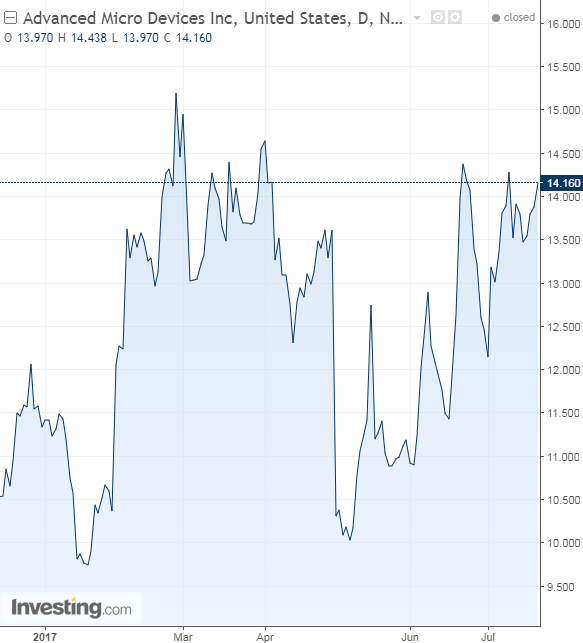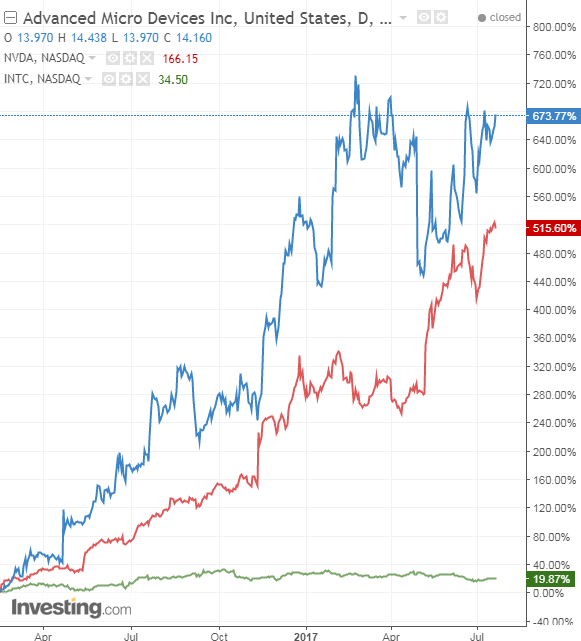by Clement Thibault
Advanced Micro Devices, Inc. (NASDAQ:AMD) is a global semiconductor company that produces microprocessors, chipsets, discrete graphics processing units (GPUs), and server and embedded processors. The company reports Q2 2017 earnings on Tuesday, July 25 after the close. Wall Street is looking for an EPS of -$0.01, on $1.15 billion in revenue.

In the past year-and-a-half, the stock's value has increased seven-fold, from around $2 in January 2016, to just above $14 as of last night's close. Savvy investors looking to initiate a position in the stock might well ask: why has the price increased? Why is it priced at around $14 if it's that good? And how much more upside can there be? The simple answer: there's quite a bit of room to grow, but fundamentals will have to follow, and at this point the risks are high.
Price Volatility
The first thing we'd like to address is AMD's share price volatility over the past few months. If you're the sort of investor who checks asset prices within your portfolio on a daily basis, AMD may not be for you. Since the beginning of the year, its share price has gone up and down routinely, within a 5 to 10 percent range on any given day. In fact, at 2.68, AMD has the third highest beta, a measure of volatility, of all companies trading on American exchanges. For comparison, a beta of 1 represents the theoretical volatility of the market, so a stock with a beta of 1.5 is 50% more volatile than the market. Following this logic, AMD is 168% more volatile than the market.
AMD's stock has become a playground for swing traders who, as a group, thrive on volatility. As a result, there's been increased volume on the stock. A year ago, three month average volume for AMD was about 22 million shares traded per day. The first time the stock hit $13.5, the area within which its current price point now resides, its average volume was 46 million. Six months later, when it touched $15 and subsequently dropped to $10, the average daily volume hit 75 million shares traded per day.
This is not a knock on the company or its shares. Rather, it's just the reality of markets. There are a lot of forces at play that anyone considering AMD stock should be aware of. Long-term investors, day traders, swing traders—though each group has its reasons for investing in or trading AMD shares, each group also has their own set of goals, both short- and long-term, which can often be oppositional. Meaning the impact of fundamental factors can be overshadowed by technical traders, at least over the short term.
With that key fact on the table, it's time to consider AMD's fundamental value.
Company Roadmap
Most of the optimism surrounding AMD is related to upcoming products, some already released, others during the remainder of 2017, some in the coming year or even later. In early March, AMD launched its new CPU, Ryzen.
Investors are hoping this new series of processors can reclaim some market share from Intel (NASDAQ:INTC), which controls about 80% of the CPU market share. The price to performance ratio is attractive, while keeping the performance comparable to Intel chips. AMD's chips, while often much cheaper than Intel's, manage to compete in performance tests with their Intel counterparts.
Since Ryzen hit the market on March 2nd, today's report will provide the first chance to evaluate the sales success of this new product. Many estimates are predicting as much as a 10% increase in market share during this quarter alone, likely garnered from the 20% Intel doesn't 'own'. With about 75 million PCs sold per quarter at an average price of $150 per unit, this would more than $1.1 billion dollars into AMD's pocket if predictions are correct.
Information and/or rumors such as this are driving AMD's price higher, preceding today's initial data.
There are more AMD product introductions on the docket, including the Vega GPU unit which is meant to compete with higher end cards from Nvidia (NASDAQ:NVDA). The launch date for the consumer-oriented Vega RX series has not yet been announced, although August seems to be a strong possibility.
In addition to CPU and GPU cards, AMD is also developing competitive server chips, via a project initially called 'Naples' but recently renamed 'Epyc.'
Hopes are high, both within the company and among committed investors, that AMD will once again become competitive with Intel and Nvidia. All signs seem to indicate that indeed they will.

Unfortunately, this means AMD's valuation isn't based on actual numbers right now, but instead on a long string of 'ifs'. Today's Q2 report will begin to answer the many questions investors still have regarding AMD's business (adoption of products by consumers, margins, and more), rather than its technology.
Cryptocurrencies
Another hypothesis making the rounds as an explanation for AMD's price surge is renewed demand for graphics cards, used for mining cryptocurrencies such as Bitcoin or Ethereum. Cryptocurrency mining demands high processing capabilities from a computer, which graphic cards such as AMD's or Nvidia's provide.
The first half of the year was extraordinary for the cryptocurrency marketplace. Digital coin valuations skyrocketed, bringing more attention and additional individuals into the arena, most requiring computer upgrades in order to mine the digital currency.
To be honest, however, we doubt this is more than just conjecture, wishful thinking on the part of AMD shareholders. The number of people trading cryptocurrencies today, though higher than ever, is still small compared to the volume of stock trades.
Bitcoin's weekly volume is 8.5 billion, while Apple's (NASDAQ:AAPL) is close to 16 billion, illustrating just how far Bitcoin has yet to go to catch up to stock adaption. The relative number of traders who also mine the currencies is surely smaller, but impossible to track given the nature of cryptocurrencies. And of course, cryptocurrencies are still far from being mainstream. This isn't to say that cryptocurrencies will never have an effect on AMD or Nvidia, but that day hasn't come yet.
Conclusion
AMD has been in negative income territory on a TTM basis since 2014, which is why the stock traded for as low as $1.6 per share in late 2015.
Given its a priori technological comeback, it definitely does not deserve to be a penny stock. AMD has plans for a brighter, more profitable future, which is something the company lacked for many years.
AMD's valuation is currently entirely driven by the momentum factor. It captures lots of new attention from traders and investors in something of a snowball effect. The stock is volatile, it goes up 100%, garners more attention which in turn drives new money into the stock, causing the price to rise on supply and demand, regardless of fundamentals. Rinse, repeat.
Nevertheless, the company has already shown some quarterly growth—18%, 15%, and 23% revenue growth in the past three quarters, but net income is still in the red, and its quarterly revenue is still lower than it was three years ago, when the stock traded for just a few dollars. Which makes today's report something worth waiting for: Q2 and beyond will show how much of the promised, rosy future might become reality, and how much market share AMD might be able to claw from competitors.
At this point, we wouldn't rush into the stock until recent business metrics become clearer. The safer play is to wait for actual sales and market share figures. Given Intel's $162 billion valuation and Nvidia flirting with a $100 billion valuation, if AMD—currently valued at $13 billion—is really going to play with the big boys, its shares (and valuation) could triple or quadruple in a few years. But right now it's still too early to tell.
If you're a momentum player, you've probably already bought the stock. If you're a conservative, long-term investor, you might as well wait for proven top- and bottom-line growth. AMD potentially tripling in value won't happen overnight. There's still enough time to hang back a bit and wait for the numbers.
